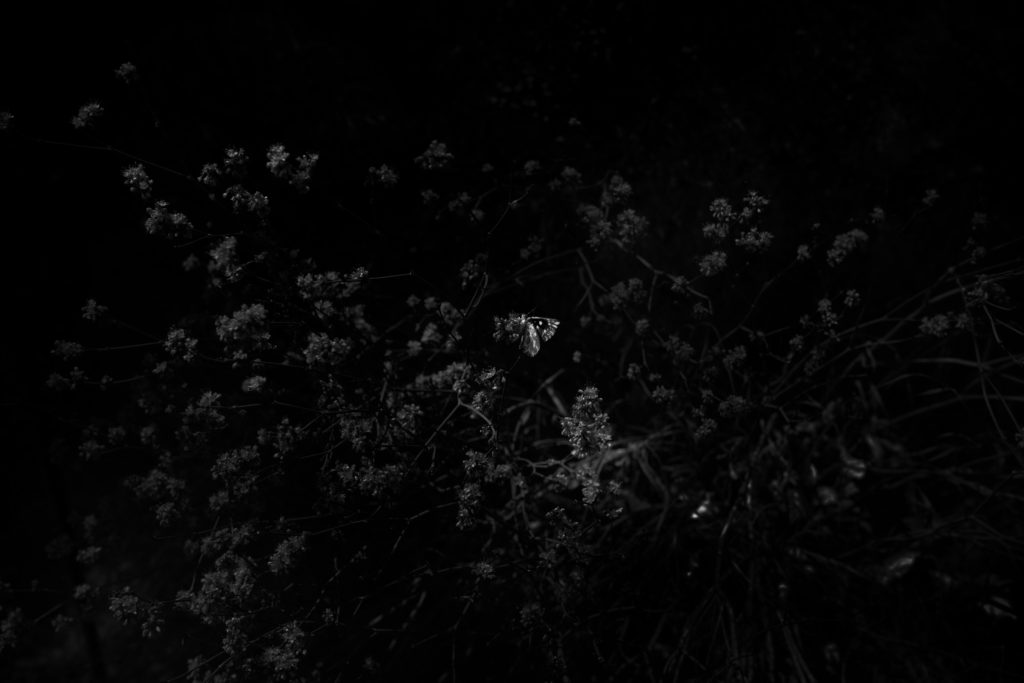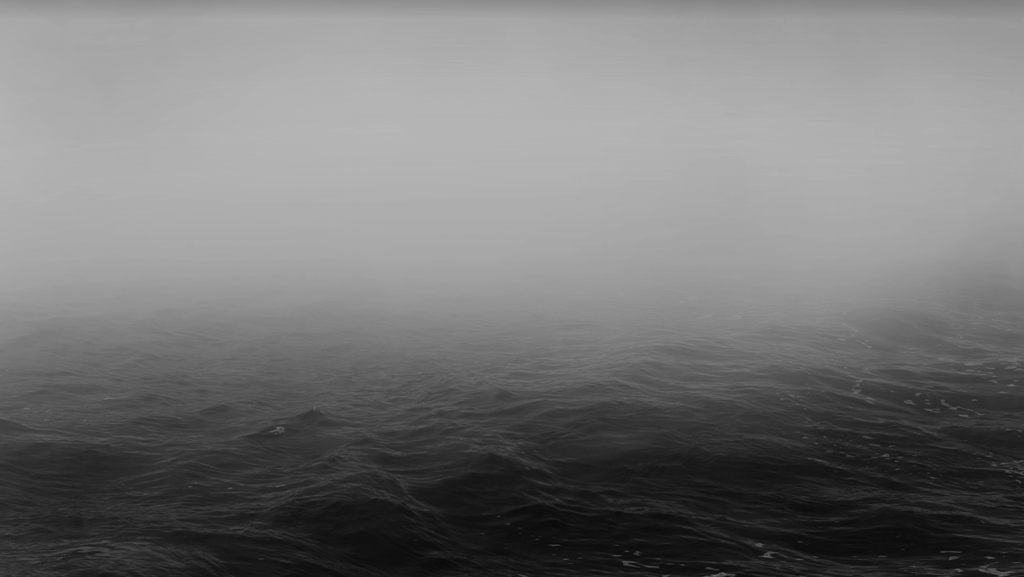As we phase out of summer and welcome the very subtle changes of fall in Southern California, the art season is ramping up and opening vibrant exhibitions to tantalize our senses and invigorate our spirits. During this time of year, we can’t help but focus on the seasons and nature — saying goodbye to the extreme heat and eagerly greeting the breezy cool nights of fall. The Orange County Museum of Art’s temporary space OCMAEXPAND is helping the public to further consider our natural world this fall with its new season of exhibitions all dealing with our relationship to nature — including the good, the bad and the complicated.

Daniel Duford, The Bees Made Honey in the Lion’s Head, from Divinations for the Coming Climate Crisis series, 2019; acrylic on panel; 16 x 16 inches; courtesy of the artist. ©Daniel Duford
This new installment of contemporary art features six new exhibitions of works by artists from the Pacific Rim, which loosely includes the western shores of North America and South America, and the shores of Australia, eastern Asia and the islands of the Pacific. The six new exhibitions act like mini-solo shows for artists Carolina Caycedo (United States/Colombia), Daniel Duford (United States), Ximena Garrido-Lecca (Peru), Mulyana (Indonesia), Robert Zhao Renhui (Singapore) and Yang Yongliang (China). On view from September 21 through March 15, 2020, the artworks presented span a wide range of artistic media and offer varied approaches to conveying creative concepts. Cassandra Coblentz, OCMA’s senior curator explained that some of the exhibitions are more conceptually driven, or politically inclined, and others take a more poetic and even playful approach.
“All of the exhibitions approach the idea of our relationship to nature in different ways,” Coblentz told us. “Each taking a different formal approach, however many of them question the ways in which industrial development has affected nature over time. Also, some explore indigenous relationships to nature that value nature as a living entity in contrast with a contemporary consumerist approach to how industries today use natural resources.”
The previous iteration of OCMA was known for a variety of exhibitions, representing a wide range of different styles of art throughout history and in contemporary art, but this new chapter of OCMA beginning with OCMAEXPAND has changed its goals to fall more in-line with the needs of our contemporary culture.
Coblentz explained that the new mission of the museum is to focus on California and the Pacific Rim in their programming. “We developed this program to offer our audiences a wide range of perspectives on the contemporary art from this very vast and complex cultural region. In presenting international artists, we are offering our community opportunities to connect to issues we relate to on a local level but also through an expanded understanding of shared global concerns.”
Coblentz curated three of the six new exhibitions, including “Carolina Caycedo: Wanaawna, Rio Hondo and Other Spirits,” “Daniel Duford: Underworld Stories Told in Tree Time,” and “Ximena Garrido-Lecca: Spectrums of Reference.”
“Wanaawna, Rio Hondo and Other Spirits” expands upon Carolina Caycedo’s previously ongoing Water Portraits series where she creates printed fabric works, still images and videos from photographs of rivers and waterfalls. She mirrors, alters and remixes them to create fascinating imagery that presents bodies of water as active and living entities that participate in our world and lives rather than remain passive and exploited by humans. This alternative reality Caycedo creates is a beautiful and dreamy world where equality is not just for humans but also for our environment, forcing viewers to consider our treatment of bodies of water today. She’s included new works of local bodies of water like the Santa Ana River, San Gabriel River, the Pacific Ocean, and Kuruvunga Springs. Caycedo will also experiment with submerging the Water Portraits in water and wrapping them around the body, among other actions, in order to create new experiential works that touch on indigenous traditions.
“Daniel Duford: Underworld Stories Told in Tree Time” brings together a series of Duford’s narrative paintings, prints and drawings that depict underground migrations and edge dwellers who emerge from the wild to tell ancient stories. Fascinated by Gary Snyder’s poem The Way West, Duford uses the landscape like an important character in his own stories. He develops the concept of “tree time,” or the slow perception of tree growth as a model for a longer narrative arc in the story of the North American landscape, which he explores through his artwork. Similar to Caycedo, Duford presents the environment as an equal participant in our world, valuing its viewpoint and offering the non-human entities in our environment the power that they lack in reality. He portrays the Earth as a living entity that can regenerate and survive over time, further supporting the untold stories in Duford’s work that are “trapped” under the urban growth we have forced upon the planet.
“Ximena Garrido-Lecca: Spectrums of Reference” also deals with industrialization and urbanization but focuses on how they have affected the relationship between nature and culture. Garrido-Lecca specifically focuses on the contemporary uses of silicon, blurring the boundaries between nature and culture. In her work, she reduces nature’s presence to an object instead of the ancient understanding of nature as a living force. By repurposing silicon scraps used to make computer chips and fragments from discarded solar panels Garrido-Lecca creates mind-blowing functional art objects like a stained-glass window and vessels inspired by pre-Columbian ceremonial ceramics that make us consider how industrialization has affected culture and how we consider and use or abuse natural elements in a capitalistic society.
The work on view in OCMAEXPAND’s new season is thoughtful, sensory and exciting but also offers timely insight into current political issues. “We are living in a moment when it is crucial for us all to be thinking about our relationship to nature,” Coblentz said, “and I always believe contemporary artists offer the richest opportunities for us to think through the most critical issues we face today.”

Robert Zhao Renhui, Image from the series Effect, 3 Kinds of Butterflies, 2019; Archival Digital black and white print; 43 x 30 inches ; courtesy of the artist. © Robert Zhao Renhui
The additional exhibitions on view are curated by independent guest curators John Silvis and Melanie Ouyang Lum. “Mulyana: A Man, A Monster and The Sea,” curated by Silvis, is made up of three immersive environments by Mulyana that depict oceanic life. His large installations of hoards and clusters of oceanic creatures act as metaphors for the beautiful, yet fragile diversity of silent marine life that is going extinct like the coral reefs. Through his work, Mulyana is able to appeal to viewers’ communal care instinct to consider how we are treating the environment.
“Robert Zhao Renhui: Effect,” also curated by Silvis, highlights the abundant presence of flies and butterflies in our environment and the strange ways in which humans treat them. In “Effect,” suspended fly traps and lures are used to reflect Zhao Renhui’s fascination with the many ways that humans have invented to exterminate insect life. He even includes 100 different fly pheromones applied to photographic panels in a warm yellow referencing the commercially produced flytraps we see every day.

Yang Yongliang, Views of Water, 2017; Digital multi-channel video; courtesy of Yang Yongliang Studio. © Yang Yongliang
“Yang Yongliang: Eternal Landscape,” curated by Melanie Ouyang Lum, is a more poetic exploration of landscape through the use of Chinese landscape paintings (shan shui). Deeply rooted in Chinese art history, Yongliang uses new media to approach shan shui landscapes as he looks for the interconnectivity between tradition and modernity, old and new, and art and technology. He uses video, photography and a virtual reality work to help create a thoughtful space for viewers to journey into the landscape of the artist’s mind and dive deep into this fascinating mix of old and new art concepts.
Coblentz hopes that through all these very different works, viewers will be inspired to think more deeply on our relationship with the environment but also to be inspired by the versatility of art-making, something that we easily forget when bombarded with so much media on a regular basis. “We hope that visitors are moved to spend time with the works on view and will be inspired to think more deeply and critically about the issues being presented in the works,” she said.”
The exhibitions will be on view September 21, 2019 to March 15, 2020 at OCMAEXPAND, South Coast Plaza Village, 1661 W. Sunflower Ave., Santa Ana; ocmaexpand.org.
Advertising disclosure: We may receive compensation for some of the links in our stories. Thank you for supporting Irvine Weekly and our advertisers.

